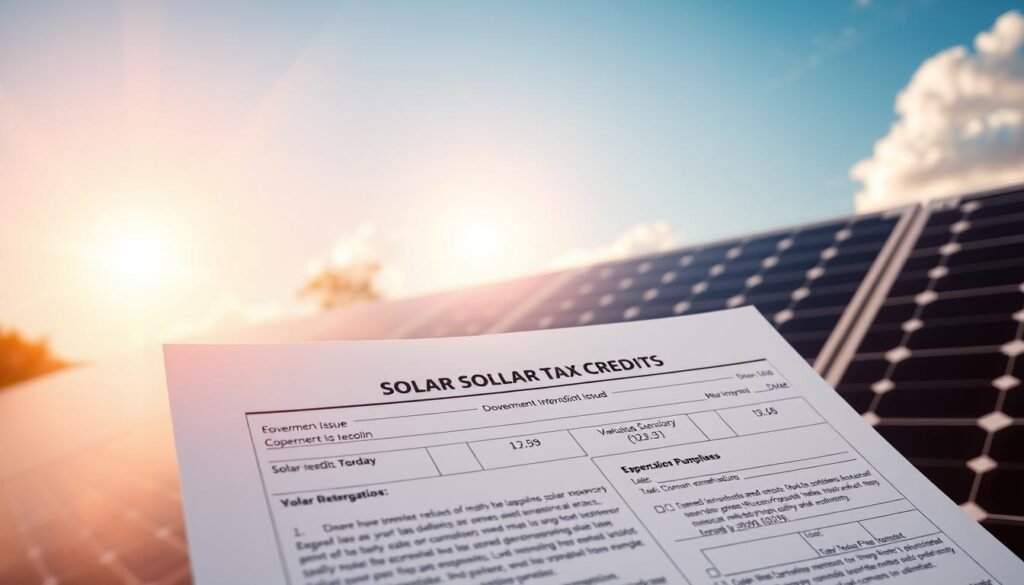The United States government is pushing for renewable energy by offering tax credits for solar panels. Homeowners and businesses can now make the switch more affordable. This move helps reduce our use of fossil fuels and lowers energy bills.
The government is offering incentives to boost the use of solar panels. These tax credits help lower the cost of installation. This way, people can save money on their energy bills over time. It’s a great way to support renewable energy and get a bonus with rebates.
Choosing solar panels is good for the planet and can save you money. With the right tax credits and incentives, you can cut your energy bills by thousands. Knowing about solar panel rebates and incentives helps you make smart energy choices. Start enjoying the perks of renewable energy today.
Understanding Federal Tax Credits for Solar Panels in 2025
The federal government gives incentives to those who invest in solar energy. This includes federal solar tax credits. These credits can lower the cost of installing solar panels and boost the investment return. The solar investment tax credit (ITC) is a major incentive. It lets people and companies claim a tax credit for part of the solar panel system cost.
To get the federal tax credits, solar panel systems must meet certain rules. They must be in a primary or secondary home and used to make electricity. The residential solar tax credit is for homeowners and renters who own the solar panels. Key benefits include:
- Lower upfront cost for solar panel installation
- Higher return on investment for homeowners and businesses
- More people using renewable energy
The current federal solar investment tax credit (ITC) rates are for systems installed from 2022 to 2032. Homeowners and businesses can get a tax credit of up to 30% of the total system cost. The federal solar tax credits can change, so it’s important to keep up with the latest info and rules.

For more details on the federal tax credits and how to claim them, talk to a tax expert or visit the official government website. By using the federal solar tax credits, people and businesses can cut their energy costs and help the planet.
| Year | ITC Rate |
|---|---|
| 2022-2032 | 30% |
State-Level Solar Incentives Across America
State solar incentive programs can help lower the cost of solar energy. Many states offer tax credits, rebates, and grants for solar installations. For example, California has a rebate for solar panels, and New York gives a tax credit for solar systems.
Some of the state solar incentive programs available include:
- California: Rebate program for solar panel installations
- New York: Tax credit for solar energy systems
- Texas: Property tax exemption for solar energy systems
It’s important to check with local authorities for specific state programs. Utility companies also offer incentives like rebates or performance-based programs to support solar energy.
By using these incentives, homeowners and businesses can lower the cost of solar panels. They can then enjoy the benefits of clean energy.
State solar incentives and renewable energy tax credits make solar energy more affordable for all.
| State | Incentive Program | Benefits |
|---|---|---|
| California | Rebate program | Up to $500 rebate for solar panel installations |
| New York | Tax credit | Up to $5,000 tax credit for solar energy systems |
| Texas | Property tax exemption | 100% property tax exemption for solar energy systems |
How to Calculate Your Solar Panel Tax Benefits
To figure out your solar panel tax benefits, look at system size, cost, and location. The federal government gives tax credits for solar panels. This can lower your taxes. Also, states and local areas offer rebates and incentives for solar energy.
First, estimate your federal tax credit. Multiply your system’s total cost by the tax credit rate. Then, add any state and local incentives you qualify for. This will give you your total tax benefits.
Estimating Federal Tax Credit Returns
The federal tax credit for solar panels is 26% of the system cost. For a $10,000 system, you get a $2,600 credit. You can use this credit on your taxes, lowering what you owe.
Adding Up State and Local Incentives
States and local areas also offer rebates and incentives for solar panels. These can change based on where you are. For example, some states give up to $1,000 rebates. Others exempt solar systems from property taxes.
| State | Solar Panel Rebate | Solar Energy Tax Incentive |
|---|---|---|
| California | $1,000 | Property tax exemption |
| New York | $500 | Sales tax exemption |
| Texas | $750 | Property tax exemption |
Using these rebates and incentives can greatly lower your solar system’s cost. This way, you can get the most out of your tax benefits.
Eligibility Requirements for Solar Energy Tax Incentives
To get solar energy tax incentives, you must meet certain rules. These rules help ensure your solar panel system is up to standard. This way, you can claim the tax benefits you’re eligible for.
Only certain solar panel systems qualify for these incentives. These include photovoltaic (PV) systems and solar water heaters. Your system must be on a primary or secondary home. You also need to have a tax liability to use the credit. For example, the solar investment tax credit lets you claim up to 30% of your system’s cost.
- Meet the equipment and installation standards set by the federal government
- Be installed on a primary or secondary residence
- Have a tax liability to claim the credit
To check if you qualify, look at your system’s manufacturer certification. Make sure the installation meets the required standards. The residential solar tax credit and federal solar tax credits have their own rules. It’s important to know these before you install your system.
By following these rules, homeowners can enjoy the benefits of solar energy tax incentives. This includes the solar investment tax credit, residential solar tax credit, and federal solar tax credits. It helps lower your taxes and makes your solar panel system more cost-effective.
Step-by-Step Guide to Claiming Solar Panel Tax Credits
To get tax credits for solar panels, you need to follow a few steps. This guide will show you what documents you need, when to file, and how to do it right. This way, you can get your solar energy tax incentives.
First, collect all the documents you need. This includes receipts for your solar panels and installation costs. You’ll also need to fill out Form 5695. This form helps you figure out how much tax credit you can get.
Required Documentation
Here’s what you’ll need to claim solar panel rebates:
- Receipts for your solar panel system and installation costs
- Form 5695, Residential Energy Credits
- Manufacturer’s certification statement for your solar panel system
Next, make sure you meet the filing deadlines and follow the right steps. The deadline for filing your tax return is usually April 15th. It’s a good idea to work with a tax professional to make sure everything is done right.
Filing Deadlines and Procedures
To get your tax credits on time, file your tax return by the deadline. If you’re not sure about anything, talk to a tax professional. They can help you and answer any questions you have.
By following these steps and using solar panel rebates, you can get the most out of your solar investment. You’ll enjoy the financial benefits of using renewable energy.
| Document | Description |
|---|---|
| Form 5695 | Residential Energy Credits |
| Manufacturer’s Certification Statement | Required for solar panel system certification |
| Receipts | For solar panel system and installation costs |
Additional Solar Energy Incentive Programs
Homeowners and businesses can save money by using solar energy incentive programs. These include solar panel rebates, renewable energy tax credits, and solar energy tax incentives. By learning about these programs, you can cut down on costs and get more value from your solar panels.
Utility companies often give rebates for installing solar panels. These rebates can be hundreds or thousands of dollars, based on the system size. There are also performance-based incentives for systems that produce more energy than expected. Plus, Solar Renewable Energy Certificates (SRECs) let you sell extra energy back to the grid.
To use these programs, you need to know the rules and how to apply them. Here are some important things to remember:
- Check with your utility company to see if they offer solar panel rebates or performance-based incentives
- Research the SREC program in your state and understand how to participate
- Review the renewable energy tax credits and solar energy tax incentives available in your area
Exploring these solar energy programs can lower your energy bills and boost the benefits of solar power. With the right mix of rebates, tax credits, and incentives, you can save more and help the planet.
| Incentive Program | Description | Benefits |
|---|---|---|
| Solar Panel Rebates | Utility company rebates for solar panel installation | Reduced upfront costs |
| Performance-Based Incentives | Bonuses for high-performing solar panel systems | Increased earnings potential |
| Solar Renewable Energy Certificates (SRECs) | Program to sell excess energy back to the grid | Additional revenue stream |
Common Mistakes to Avoid When Claiming Solar Incentives
When you claim solar incentives, like tax credits for solar panels, it’s key to know common mistakes. One big error is wrong documentation. This can cause delays or even have your claim rejected. Always check your paperwork carefully to make sure it’s right and complete.
Another mistake is missing deadlines. Solar energy tax incentives and rebates have specific times to apply. If you miss these, you could lose out on the benefits. Getting help from tax experts can help you meet deadlines and file correctly.
- Incorrectly calculating the value of tax credits for solar panels
- Failing to meet the eligibility requirements for solar energy tax incentives
- Not keeping accurate records of solar panel installation and maintenance
Knowing these common mistakes and how to avoid them can help you get the most from solar incentives. This includes tax credits for solar panels and rebates.
Conclusion: Maximizing Your Solar Investment Benefits
The solar investment tax credit, residential solar tax credit, and other federal solar tax credits offer big financial benefits. They help homeowners who choose solar energy. By knowing the latest incentives and claiming these benefits, you can get the most out of your solar panels. This leads to long-term savings on your energy bills.
Solar energy is a wise choice for many reasons. It helps reduce your carbon footprint, boosts your property value, and cuts down on utility bills. Using tax credits and incentives can make your solar system even more affordable. Always consult with tax experts and keep an eye on policy updates to get the most from your solar investment.











I’m really inspired together with your writing skills and also with the structure on your weblog. Is that this a paid topic or did you customize it your self? Anyway keep up the excellent quality writing, it is rare to look a nice weblog like this one today!